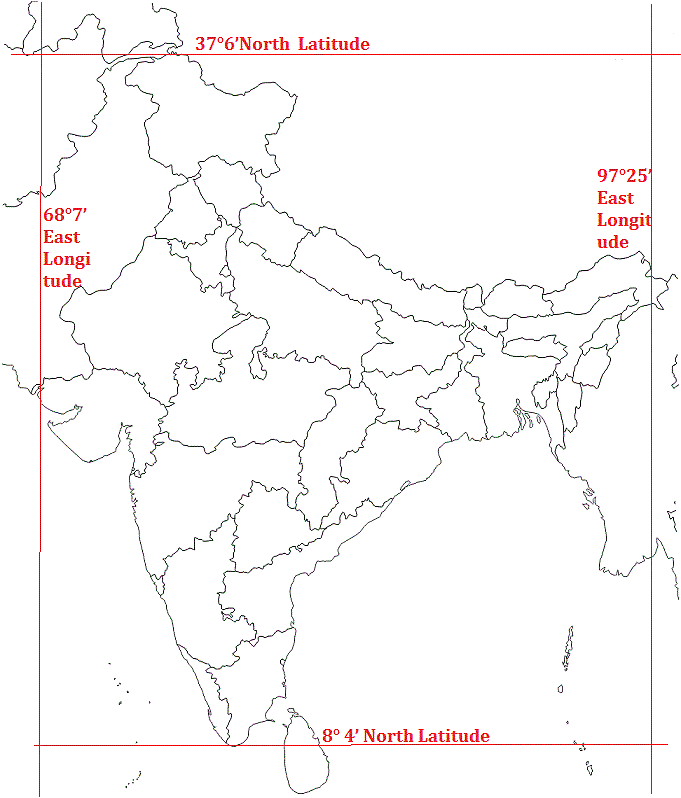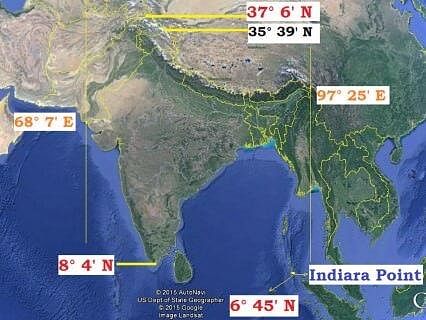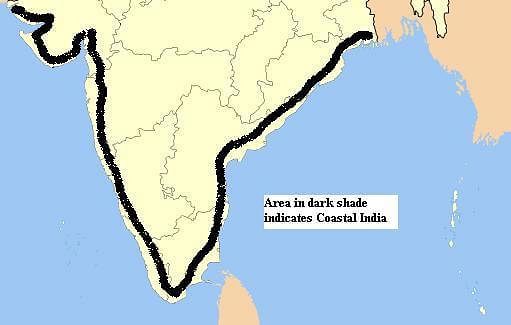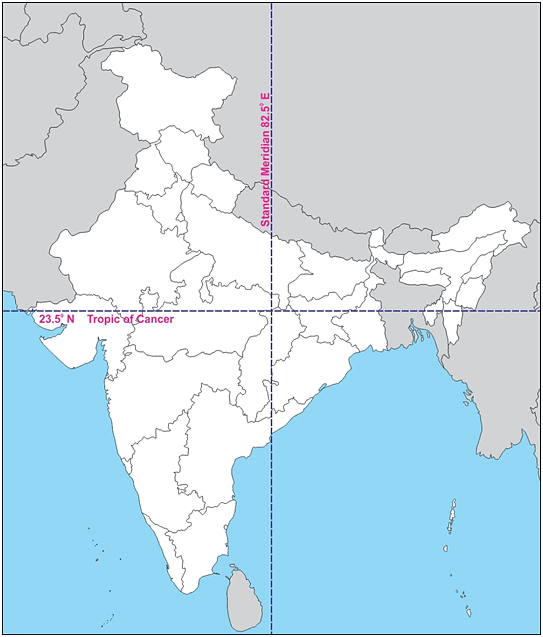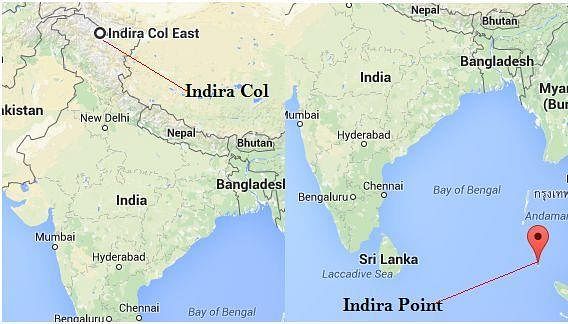Class 9 Geography Chapter 1 Previous Year Questions - India - Size and Location
Q1. What is the longitudinal extent of India? State its two implications. [Important]
Ans: The mainland of India extends between longitudes 68°7′E and 97°25′E. The east-west extent is 2933 km in length.
Longitudinal Extent of India
The longitudinal extension shows that India is located in the Eastern Hemisphere and places can be located with reference to longitudes.
On account of the 30° longitudinal extension (97°25′–68°7′ = 29°18′, approximately 30°) there is a time difference of 2 hours (30°×4 min = 120 mins or 2 hours) in local time between the eastern and western limits of India. However, a standard time (5 hours 30 min ahead of G.M.T.) is adopted according to the local time of the central meridian of the country, 82°30′E.
Q2. Describe briefly the geographic location of India in Asia. What is the significance of India’s geographic location?
Ans: The Indian landmass has a central location between the East and the West Asia. India is a southward extension of the Asian Continent. The trans-Indian Ocean routes which connect the countries of Europe in the west and the countries of East Asia provide a strategic central location to India. The Deccan Peninsula protrudes into the Indian Ocean, thus helping India to establish close contact with oil-rich countries of West Asia as well as Africa and Europe from the western coast and the Southeast and East Asia from the eastern coast via sea and ocean routes and air routes.
Q3. What is the latitudinal extent of India? How does it affect India?
Ans: The latitudinal extension of the mainland of India is between 8°4′ N and 37°6′ N. The north-south extension is 3214 km in length.
Latitudinal Extent of IndiaThe latitudinal extension shows that India is located entirely in the Northern Hemisphere. The wide latitudinal extent of nearly 30 degrees results in wide variation in climate. The southern parts get more heat from the sun than the northern parts. Differences in the duration of day and night is much less in the south of India at lower latitudes, e.g. as in Kanyakumari. But the difference increases further north, e.g. as in Jammu and Kashmir, as it is further away from the equator.
Q4. What is the southernmost point of the Indian Union called? Describe its location in India and its current situation.
Ans: The southern-most point of the Indian Union is known as the Indira Point. It is located on the Nicobar Islands, the southern section of the Andaman and Nicobar group of islands. The islands are located in the Bay of Bengal lying to the southeast of India’s mainland.
The Indira Point got submerged under the seawater in December 2004 during the destructive Tsunami that hit the Andaman and Nicobar Islands.
Q5. Why is the difference in day and night very little in Kanyakumari while it is not so in the northern part of the country? Give specific reasons for your answer.
Ans: Kanyakumari in Tamil Nadu is located at the southernmost tip of India’s mainland. The latitude 8°4′ N passes close to it.
Kanyakumari Port The place is thus near the equator and lies close to the equatorial region. As the sun shines directly over the equator all throughout the year, the duration of day and night is almost equal here. Hence, in Kanyakumari, the difference in the duration of day and night is very little - maximum around 45 minutes only. But in the northern part of the country located to the north of the Tropic of Cancer away from the equator, the difference between the length of day and night becomes increasingly greater.
Q6. How have mountain passes been helpful to India since historic times?
Ans: The various mountain passes across the Himalayan range and other mountains in the north have provided passages to travellers since ancient time. The land routes via mountain passes have contributed to the exchange of ideas and commodities since historic times.
The ideas of Upanishads and the Ramayana, the stories of Panchtantra, the Indian numerals and the decimal system could thus reach many parts of the world. The spices, muslin and other merchandise were taken from India to different countries. On the other hand, the architectural styles of dome and minarets from West Asia and the influence of Greek sculpture, which can be seen in different parts of India, came from other countries to India.
Q7. How has the long coastline been beneficial to India?
Ans: The Arabian Sea and the Bay of Bengal, extensions of the Indian Ocean, lie to the west and east of the Indian Peninsula, and the Indian Ocean lies to its south.
Coastal Line of India The total length of the coastline of the mainland of India including Andaman & Nicobar and Lakshadweep is 7516.6 km. The long coastline of India has helped in maritime trade since ages. The central location of India at the head of the Indian Ocean has provided it with a strategic location along the trans-Indian Ocean routes.
India is able to establish close contact with West Asia, Africa and Europe from western coast and with Southeast and East Asia from the eastern coast. The long coastline has also played a major role in influencing the climate of India. It provides opportunities for fishing and extraction of petroleum. It serves as a natural boundary protecting India.
Q8. Which ocean is named after India? Give two reasons as to why it was named after India. [Important]
Ans: The Indian Ocean is named after India. India is the only country which has the credit of an ocean named after it.
The Arabian Sea and the Bay of Bengal, extensions of the Indian Ocean, lie to the west and east of the Indian Peninsula, and the Indian Ocean lies to its south. No other country has a long coastline on the Indian Ocean as India. The central location of India at the head of the Indian Ocean has provided India with a strategic location of great significance along the trans-Indian Ocean route. It is India’s eminent position in the Indian Ocean which justifies the naming of the ocean after India.
Q9. What is the Standard Meridian of India? From where does it pass?
Ans: The Standard Meridian of India (82°30′ E) passing through Mirzapur in Uttar Pradesh is taken as the Standard time for the whole country.
Standard Meridian of India
Q10. What was the contribution of land routes to India in ancient times? Explain any three.
Ans: India's contacts with the outside world have continued through the ages, through the land routes and sea routes.
(i) These routes have contributed to the exchange of ideas and commodities since ancient times. The ideas of Upanishads and the Ramayana, the stories of Panchtantra, the Indian numerals and the decimal system could reach many parts of the world.
(ii) The spices, muslin and other merchandise were taken away from India to different countries through these land routes.
(iii) The influence of Greek sculpture and the architectural styles of domes and minarets from West Asia can be seen in different parts of our country.
Q11. Which meridian has been selected as the Standard Meridian of India?
Ans: (i) 82°32′ E has been selected as the Standard Meridian of India.
(ii) From Gujarat to Arunachal Pradesh, there is a time lag of two hours. To bring the whole country under one-time set, 82°32′ E latitude which passes at the centre of the country is taken as a standard time for the whole country in order to maintain uniformity of time.
Q12. Why India is called a subcontinent? Write any three points.
Ans: India is called a subcontinent because of the following reasons:
(i) It is a distinct geographic unit separated from the Asian continent by the majestic Himalayas and its extensions.
(ii) It has its own culture as distinct from the rest of Asia.
(iii) The climate of the Indian subcontinent is characterised by the monsoon type of climate.
Q13. What is latitude? What is the latitudinal extent of India?
Ans: (i) The position of a place, measured in degrees North or South of the equator. It is mostly calculated on the basis of the angular distance of a place north-south of the equator.
(ii) The mainland of India extends between latitudes 8°4′ N and 37°6′ N and longitudes 68°7′ E and 97°25′ E.
Q14. Name the southernmost point of the Indian Union. It is visible today?
Ans: The southernmost point of the Indian union is 'Indira point'.
Indira Point It submerged under the seawater in 2004 during the Tsunami. The entire landmass was erased from the map of India.
Q15. Do you think naming the Indian Ocean after a country is justified?
Ans: Yes, because no other country has a long coastline on the Indian Ocean as India has. It is because of India's eminent position in the Indian Ocean which justifies the naming of an ocean after it.
Q16. How does India occupy an important strategic position in South Asia? Illustrate your answer by explaining three suitable points.
Ans: India occupies an important strategic position in South Asia on the following points:
(i) The Indian landmass has a central location between East and West Asia.
(ii) The trans-Indian ocean routes which connect the countries of Europe in the west and the countries of East Asia provide a strategic central location to India.
(iii) The Deccan peninsula protrudes into the Indian Ocean has helped India to establish close contact with West Asia, Africa and Europe from the western coast and with Southeast and East Asia from the eastern coast.
Q17. What is the latitudinal extent of India? How is the latitudinal spread in India advantageous to her? State two points.
Ans: The latitudinal extent of India lies between 8°4′ N and 37°6′ N. This means that the longitudinal expanse is about 30° from west to east. The advantages of longitudinal spread:
(i) influences the duration of the day and night as one moves from South to North
(ii) It also helps to take advantages of the Indian Ocean, the Arabian Sea on the west and the Bay of Bengal on its east for sea movements.
Q18. Give a reason for the following statement :
(a) 82° 30 E Latitude has been selected as the Standard Meridian of India.
(b) The distance between India and Europe has been reduced by 7000 km. with the opening of the Suez Canal.
(c) Days and nights are almost of equal duration at Kanniyakumari.
Ans: (a) There is a time lag of at least 2 hours if one moves from west to east – from Gujarat to Arunachal Pradesh. The local time at Arunachal Pradesh would be at least 2 hours ahead of Gujarat. To avoid such differences in local time, Indian Standard Time (IST) has been fixed on 82°30′ E to give the whole country a uniform time.
(b) Before the opening up of Suez Canal in 1869, ships from Europe had to make detour journey via (Cape of Good Hope) African coast after traversing a distance of about 15000 km.
(c) Kanniyakumari in Tamil Nadu is located at the southern-most tip of India’s mainland. The latitude 8°4′ N passes close to it. The place is thus near the equator and lies close to the equatorial region. As the sun shines directly over the equator throughout the year, the durations of day and night are almost equal here. Hence, in Kanniyakumari the difference in the duration of day and night is very little, maximum around 45 minutes only.
Q19. Why is there a difference of 2 hours in local time between the easternmost part of Arunachal Pradesh and westernmost part of Gujarat? Explain.
Ans: The local time in Arunachal Pradesh is two hours ahead of Gujarat because of longitudinal differences. Time is calculated on the basis of 4 minutes for every 1° of longitude towards East and West of Greenwich Meridian Time (GMT). The difference between Arunachal and Gujarat is 30° East longitude. Therefore, the differences in time between these two places 30 × 4 = 120 minutes or two hours.
Q20. Explain why Ahmedabad and Kolkata can see the noon sun exactly overhead in a year but not Delhi.
Ans: Kolkata and Ahmedabad are located very close to the Tropic of Cancer and as such both places see the noon exactly overhead in a year. Delhi, on the other hand, is located far north of the Tropic of Cancer and does not enjoy it.
Q21. Why do we need a Standard Meridia for India? Explain.
Ans: Due to the vastness of the country, there is a difference of time between places as one moves from east to west and vice versa. In order to set right this problem, Standard Meridian is needed.
|
53 videos|437 docs|80 tests
|
FAQs on Class 9 Geography Chapter 1 Previous Year Questions - India - Size and Location
| 1. भारत का आकार और स्थिति क्या है? |  |
| 2. भारत की भौगोलिक स्थिति का क्या महत्व है? |  |
| 3. भारत की सीमाएं किन देशों के साथ लगती हैं? |  |
| 4. भारत की विशेष भौगोलिक विशेषताएं क्या हैं? |  |
| 5. भारत का जलवायु क्षेत्र क्या है और यह कैसे प्रभावित करता है? |  |

|
Explore Courses for Class 9 exam
|

|
